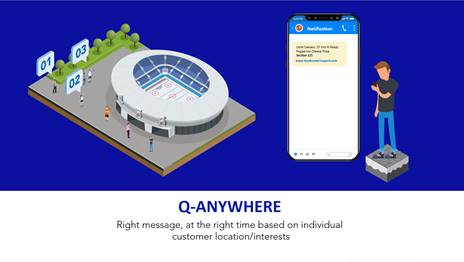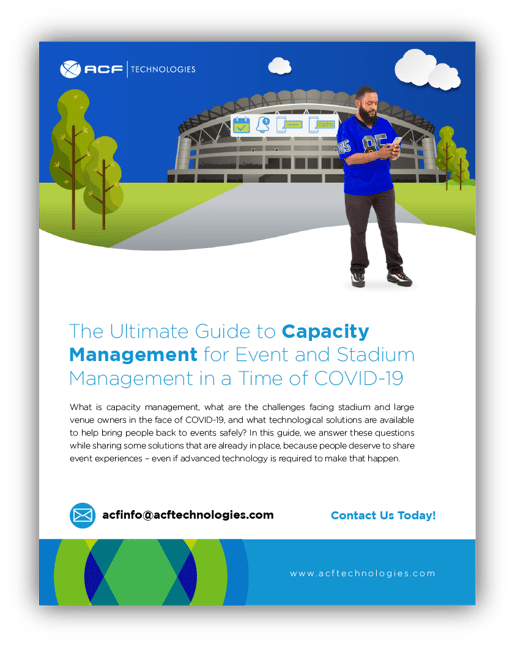What is capacity management, what are the challenges facing stadium and large venue owners in the face of COVID-19 and what technological solutions are available to help bring people back to events safely? In this blog, we answer these questions while sharing some solutions that are already in place, because people deserve to share event experiences – even if advanced technology is required to make that happen.
What is Capacity Management?
How do companies who run large venues deal with capacity management in a time of COVID-19? Capacity management, which is defined as “the act of ensuring a business maximizes its potential activities and production output – at all times, under all conditions” is more of a challenge now than ever – place a huge burden on event and stadium management.
First, event venues were closed. Then some re-opened with limitations about how many seats could be filled. Now there’s the issue of how to get people in and out of venues – a huge challenge with the CDC recommending that fans practice social or physical distancing of at least 6 feet from other. That’s not to mention the psychological fear of being close to other people that will prevent some fans and delegates from returning to live events at all. It’s a challenging time.
As Greg Banecker, from Gateway Ticketing Systems, says, "No matter what, when we reopen, we're not coming back to the world we once knew."
Challenges in Capacity Management
How do you continue to provide exciting events that sports and music fans demand when social distancing restrictions are in place? In collaboration with state and local health officials, the CDC is now allowing event planners and officials to determine whether and how to implement considerations to protect event attendees. The CDC is recommending:
- Promoting healthy behaviors that reduce the spread of COVID-19
- Maintaining healthy environments
- Maintaining healthy operations and
- Preparing for when someone gets sick.
Covering everything from restrooms and disinfection to the use of signs and messages, the installation of physical barriers and the staggered use of shared indoor spaces, event organizers have a responsibility to do everything they can to protect event attendees while still making events a physical possibility.
However, the meaning of ‘being safe’ differs from country to country and even city to city. For example, in Texas, stadiums are allowed to seat fifty percent of their capacity, while The Miami Dolphins have proposed “capacity” crowds of 15,000 at Hard Rock Stadium, which normally can seat upwards of 80,000 people.
Consideration is also being given to stadium reconfiguration. Soccerex reports that Old Trafford, home to Manchester United, has been given the go-ahead to test 1,500 standing rail seats. While Architect and engineering firm DLR Group suggests that “traditional ‘loge box’ seating, with four seats separated by six feet in all directions, would honor distancing rules”, another possibility is removing every other row and then every other seat. This would reduce capacity while complying with social distancing guidelines.
Stadium Infrastructure Was Not Designed for Social Distancing
Regardless of how stadiums choose to re-imagine their seating to accommodate new rules, it will continue to pose a challenge as long as the specter of social distancing still looms. The fact is that stadium infrastructure is simply not designed with social distancing in mind. The challenge for sports, music or other fans and people attending events is that the stadium environment was designed to squeeze as many people in as possible to enjoy a shared experience. The challenge for stadium owners and events managers is that putting on an event requires crowd planning strategies that go far beyond seating.
Coping with crowds that need to be in place for a specific start, yet stay a certain distance away from each other at all times requires re-thinking the entire stadium experience. For example, when preparing a stadium or large area for an event many questions have to be answered such as:
- How will venues deal with entries at the turnstiles hours before game-time?
- And how will they cope with the lengthy half-time queues for the bar and toilets?
- What if someone attempts to take their seat five minutes after the restart or between plays? It is hard enough trying to make room for a latecomer, without having to adhere to the principle of staying two meters away from everybody.
Then there is also the need to address continuing uncertainty as social distancing rules change. Stadiums must build elasticity and flexibility into their re-opening strategy to accommodate rule relaxations as well as the tightening of rules. For example, if another wave of COVID-19 sweeps across the planet, stadiums may need to adjust their capacity on short notice.
But, arguably more importantly, the experience must remain as pleasant and engaging as possible – from the moment fans head into a stadium or event environment until they leave.
Lessons from Around the World
While attractions in Asia have reopened and are checking people's temperatures, instituting capacity limits, and reducing dwell time, the biggest lesson we can learn from the attractions industry is their capacity management strategies.
These 'capacity managed attractions' use timed tickets—a system not unlike virtual queuing or virtual queue management. Customers join a virtual queue, regardless of location, then, shortly before a ride (or an agent) is available, they are sent an alert to come to a staging area, or 'On-Deck.'
Other global technologies have also been helping event managers the time of COVID. For example, in Europe, Dutch soccer side, AFC Ajax has already employed facial recognition to verify online ticket sales while in LA, a Chicago-based concession company is using a robot called Flippy to improve efficiencies inside stadiums: which could reduce queuing. Tropicana Field, the St. Petersburg home of Major League Baseball’s Tampa Bay Rays, has also automated its financial processes. They went completely cash free in 2019: a move that reduces the risk of virus transmission through the handling of cash.
How Stadium Technology Will Support Re-opening
No one can say for sure what the fan experience will be like moving forward, but significant investment and carefully thought-out plans are required to balance safety and security with comfort and ease. One fact remains: as the International Association for Sports and Leisure Facilities (IAKS) puts it, “The entrance procession is an integral part of the visitors’ experience, so this should be as efficient and enjoyable as possible.” Once stadiums, arenas, and ballparks can welcome fans again, we think people will be eager to cheer on their favorite teams. But they’ll also want to feel safe in doing so.
This can be accomplished through stadium technology like:
- Virtual queue management
- Increased digital signage for wayfinding and alerts
- Venue-specific apps that hold tickets and provide real time information about concessions, restrooms and retail
- More emphasis on sanitization and hygiene via touch-free, grab-and-go and cashless interactions.
And, as events organizers know very well and IAKS confirms, “Encouraging fans to arrive early at the stadium, and leave well after the event, is a well-established concept that helps to minimize crowding, increase fan entertainment and increase revenue generation”. Stadium organizers need all the help they can get to ensure event attendees can increase dwell time while remaining safe. How do they do it?
Virtual Queue Management
In an effort to ease the burden for fans and event attendees, stadium owners will need to invest in crowd intelligence systems that utilize Artificial Intelligence (AI), sensors and advanced algorithms, the track queues and wait times both inside and outside the stadium.
A virtual queue is one way stadiums and events can manage crowd capacity, so that fans are not physically standing in line hours before the event begins. A virtual queue gives fans a time allocation to arrive at their allocated gate without requiring them to actually line up.

Facial Recognition
More complex stadium technology solutions have also been mentioned, including facial recognition at gates, walkthrough disinfectant machines, thermal cameras for fever detection, enhanced audio and video communications efforts to reinforce and monitor processes and procedures, and security systems that control access and enforce physical distancing. The goal will be to minimize touchpoints: doors, tickets, lights, toilets, concessions, money, handles and so-on.
Wayfinding and Digital Signage
Until now, wayfinding has played an important role in helping fans navigate complex stadiums. Fans need to know where they are and where they are going to ensure a smooth flow of people throughout the stadiums.
In a world of COVID-19 indoor wayfinding will play an even more important role in people management. Once fans or delegates enter a venue, they need to know how to participate in the rest of event experience: from buying food and drinks to going to the toilet. Organizers will know every inch of their venue, but fans will not. An effective wayfinding system will stop fans from getting frustrated or stressed, and ultimately it will have a positive impact on how visitors perceive the facility.
This step requires highly adaptive technology which can display real-time information. Traditional or digital signage can be used to show information, directions and warnings. Ideally, though, intelligence information will be displayed across mobile devices and dedicated screens everywhere from turnstiles to toilets, food and beverage outlets to fan stores. With virtual queue management this is possible. The result is that fans and event attendees know about queue times in advance which ultimately empowers them to make informed decisions about when and where they go for their food and drinks.
Crowd Intelligence
For an ultimate attendee experience queue management, wayfinding and digital signage can be combined with real-time dashboard analytics about the density and flow of people, while enabling data-driven decisions around gate crowding, event staffing, security and sanitation. That’s where solutions like crowd intelligence can add extra value.
What Can Stadiums Learn from Waiting Rooms?
In retail, clinical and governmental contexts customers and citizens have had to adjust their behavior when it comes to queuing. Social distancing guidelines have limited the ability to allow customers to check-in for appointments and services by using a kiosk or interfacing with the reception desk. And in most cases, access to the lobbies and waiting areas is restricted to employees and a limited number of screened customers or patients.
So, how can apply the lessons that are already being used in other contexts to optimize for capacity management challenges in the entertainment sector? The lesson here is about a combination of preparation, timing, digital information and warning people virtually.
Bringing People ‘On Deck’: The Value of a Staging Area
One solution is to bring a smaller number of the total capacity of an area into a staging or waiting area virtually – preparing them by putting them ‘On-Deck’. In a stadium context, putting hundreds or even thousands of people in a physical ‘waiting space’ doesn’t really solve the social distancing problem. But what if we make the ‘pre-waiting area’ a fan’s car? A digital system can limit the number of people heading towards a specific gate at a specific time, meaning that ticket-takers (who may also be temperature-takers in some instances) can manage the flow of fans far more effectively.
Instead of forcing people to queue outside when a specific gate hits capacity, virtual queuing technologies notify customers or fans when they're close to being served or allowed in. Then depending on the entry process or average wait time for each stadium or large area, event attendees can be pre-prepared by inviting them into your waiting area.
Does it have to be a real waiting area? Nope. Let’s face it, there aren’t a lot of good spaces to wait outside a stadium or large event venue. The staging area is more about a concept than a physical space. Staging people is about getting them closer, and getting them ready. Your equivalent of a waiting room might be an outdoor area in closer proximity to the entrance they need to use to access the venue, or you might want to keep them in their own space (like their car, or a coffee shop down the street) and then bring them On-Deck when it’s time.
How Long Does It Take? How Much Space Do You Have
As we already know, making the guest experience as painless as possible requires event managers to put the right planning and infrastructure in place to support them. To balance the risk of getting fans or delegates too close to each other, we need to know the answers to a few questions:
- How many people will arrive
- How far away from each other do they have to stand
- How much space is there for them to stand in outside of the stadium
- How long will it take to ‘process them’ to get them into the venue safely.
For example, it might take an average time of 2 minutes to check someone’s temperature, their bags, their ticket and their face. Under new social distancing guidelines you can only accommodate a certain number of people in a line and you need to keep them six feet apart (at least). You probably don’t want to have to keep fans or delegates waiting in a queue for longer than 20 minutes either. So the answer is to prepare ‘batches’ of fans – as many as your processes and space can accommodate – and alert a new batch every 20 minutes.
The Technology Makes it Easy
But don't worry too much about calculating your notification times. Systems like our Q-Anywhere suite will help you determine the optimal flow and time to bring fans and delegates On-Deck, based on your real-time data.
The good news about that is if the queues move faster than expected, you can also update them in real-time to let them know they can get into the venue more quickly.
If you take a look at the details of how technology like On-Deck virtual capacity management works, you'll realize it's pretty simple and pretty nifty stuff.
- Bi-directional SMS messaging allows people who are going to a venue to wait at home, in a coffee shop or their cars until they receive an SMS or text-based invitation that prepares them to head to your waiting area – whether that’s a real waiting area outside a gate, or just a virtual ‘phasing area’ that mentally prepares them to head towards the real waiting area.
- Wait Anywhere enables you to set the number of customers you want to allow in your waiting area at any one time. This is a configurable value that can be set based on the space’s capacity.
- Once the event attendee has entered the waiting area you have defined, you can follow your standard processes for entry and send them to the right gate, safely and seamlessly.
Capacity Management Solutions Can Keep the Stadium Doors Open
Capacity management guidelines are presenting organizations with a unique set of challenges and keeping the doors open means embracing new ways of working while avoiding customer flow bottlenecks.
ACF's On-Deck and Virtual Waiting Room technologies can improve the customer experience by removing the bottlenecks associated with capacity management constraints.
It takes away some of their anxiety, ensures social distancing is enforced, and helps control customer flow. And this, in turn, reduces the pressure on public-facing staff members at the same time.
In short, being able to Wait Anywhere and be alerted with On-Deck technology, Check-in Anywhere, or get an Assistant Anywhere isn't just a fad. Social distancing is here to stay.
Conclusion: Keep Them Coming, Keep Them Safe: Virtual Queuing Might Be the Answer You Didn’t Know You Were Looking for
If you want to keep stadiums or entertainment venues occupied you have to help people get in and out of them safely with as little fuss as possible and help them move around the venue securely so they can relax, enjoy and spend more money while they’re there. Sure, visiting a stadium in the time of COVID-19 is going to be a completely new experience for delegates and fans, but nothing about the new normal will be normal.
The answer to keeping sports, the arts, and any other live events alive is to help fans, delegates and customers come to venues and share in the experience in a safe, convenient, and socially responsible way. Getting them On Deck with virtual queuing might just be the answer.
Did you enjoy this blog post? Click below to download our full guide!

Need help? We're here for you
If we can provide help and assistance on anything related to queue management and virtual queuing, we're happy to do so. Get in touch. And stay safe.





